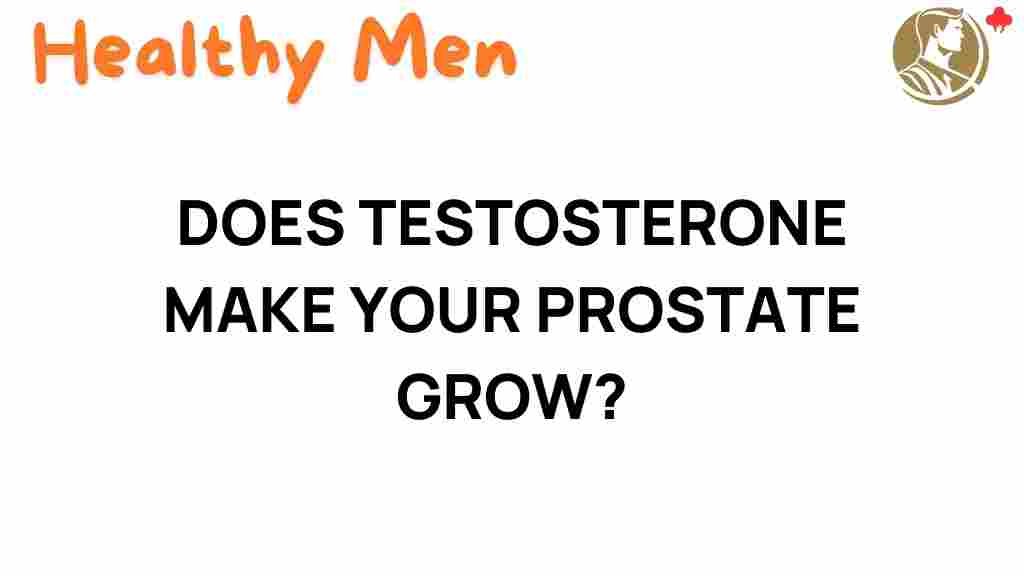Unraveling the Truth: Does Testosterone Really Influence Prostate Growth?
The relationship between testosterone and prostate growth has been a subject of considerable debate in the realm of men’s health. As men age, they often experience changes in hormone levels, particularly testosterone, which can lead to various health concerns, including issues related to prostate health. Understanding this relationship is crucial for addressing health risks associated with aging and maintaining a healthy endocrine system. In this article, we will explore the effects of testosterone on prostate growth, review medical research, and provide insights into managing prostate health.
Understanding Testosterone and Prostate Growth
Testosterone is the primary male sex hormone, playing a vital role in various bodily functions, including muscle mass, bone density, and libido. However, its influence extends beyond these functions, particularly when it comes to prostate health. The prostate, a small gland located below the bladder, is responsible for producing seminal fluid. As men age, the prostate can undergo changes that may lead to enlargement, a condition known as benign prostatic hyperplasia (BPH).
Research indicates that testosterone levels can impact prostate growth. Here’s how:
- Testosterone Conversion: Testosterone can be converted into dihydrotestosterone (DHT), a more potent androgen that is directly linked to prostate growth.
- Age-Related Changes: As men age, testosterone levels typically decline, but the prostate may still respond to existing testosterone, leading to growth.
- Health Concerns: Low testosterone levels can also lead to various health concerns, including sexual dysfunction and decreased energy levels.
The Role of Hormone Levels in Prostate Health
Maintaining balanced hormone levels is essential for overall health, particularly for men as they age. Fluctuations in testosterone can lead to various issues, including:
- Increased risk of prostate enlargement.
- Potential development of prostate cancer.
- Impact on sexual health and libido.
Medical research has shown that while high levels of testosterone can contribute to prostate growth, low levels can also result in adverse health effects. Thus, the key lies in maintaining optimal testosterone levels to support prostate health.
Medical Research on Testosterone and Prostate Growth
Numerous studies have sought to explore the intricate relationship between testosterone and prostate growth. Some key findings include:
- A study published in the Journal of Urology found a correlation between elevated testosterone levels and increased risk of BPH.
- Research has indicated that men undergoing testosterone replacement therapy may experience changes in prostate size and function, emphasizing the need for careful monitoring.
- Other studies suggest that while testosterone can promote prostate growth, it is not the sole factor, with genetics and lifestyle also playing significant roles.
These findings highlight the complexity of hormone interactions within the body, particularly concerning the endocrine system and its influence on men’s health.
Step-by-Step Guide to Managing Prostate Health
To maintain prostate health and manage the effects of testosterone on prostate growth, consider the following steps:
1. Regular Monitoring of Hormone Levels
Consult with a healthcare provider to monitor testosterone levels regularly, especially as you age. This can help identify any hormonal imbalances early on.
2. Healthy Diet
A balanced diet can significantly influence hormone levels and overall health:
- Include: Fruits, vegetables, whole grains, lean proteins, and healthy fats.
- Avoid: Processed foods, excessive sugar, and saturated fats.
3. Regular Exercise
Engaging in physical activity can help maintain healthy testosterone levels and support prostate health:
- Aim for at least 150 minutes of moderate aerobic exercise each week.
- Incorporate strength training exercises to promote muscle health.
4. Limit Alcohol and Tobacco Use
Both alcohol and tobacco can adversely affect hormone levels and prostate health. Limiting or eliminating these substances can improve overall well-being.
5. Regular Check-ups
Proactive healthcare is essential. Regular check-ups can help identify any potential prostate issues early, facilitating timely intervention.
Troubleshooting Common Concerns
While managing testosterone and prostate health, you may encounter some common concerns:
Low Testosterone Symptoms
Signs of low testosterone can include:
- Fatigue and low energy levels.
- Decreased libido and erectile dysfunction.
- Loss of muscle mass.
High DHT Levels
If you experience symptoms of prostate enlargement, such as:
- Frequent urination, especially at night.
- Difficulty starting or stopping urination.
- Weak or interrupted urine flow.
Consult with a healthcare professional for appropriate testing and treatment options.
Conclusion: The Importance of Balance
In conclusion, the influence of testosterone on prostate growth is a complex interplay of hormone levels, aging, and individual health concerns. While testosterone can contribute to prostate enlargement and other issues, maintaining balanced hormone levels is essential for optimal prostate health. Regular monitoring, a healthy lifestyle, and proactive healthcare can help mitigate risks associated with hormonal fluctuations.
As men navigate the challenges of aging and hormonal changes, understanding the connection between testosterone and prostate health becomes increasingly important. By taking a proactive approach to managing hormone levels and overall health, men can support their prostate health and enhance their quality of life.
For further reading on testosterone and its impact on men’s health, consider checking out this comprehensive guide. If you have specific concerns about your hormone levels or prostate health, consult a healthcare provider for personalized advice and treatment options.
This article is in the category Conditions and created by healthymen Team
